
1a Palace Gate is a Grade II* listed house on Palace Gate, Kensington in London, England.
Construction of the house began in 1896 and was completed in 1898 by the architect C. J. Harold Cooper for William Alfred Johnstone. [1]

1a Palace Gate is a Grade II* listed house on Palace Gate, Kensington in London, England.
Construction of the house began in 1896 and was completed in 1898 by the architect C. J. Harold Cooper for William Alfred Johnstone. [1]

Friar Park is a Victorian neo-Gothic mansion in Henley-on-Thames, England, construction began in 1889 and was completed in 1895. It was built for lawyer Sir Frank Crisp, and purchased in January 1970 by English rock musician and former Beatle George Harrison. The site covers about 30 acres, and features caves, grottoes, underground passages, a multitude of garden gnomes, and an Alpine rock garden with a scale model of the Matterhorn.

Bushy Park in the London Borough of Richmond upon Thames is the second largest of London's Royal Parks, at 445 hectares in area, after Richmond Park. The park, most of which is open to the public, is immediately north of Hampton Court Palace and Hampton Court Park and is a few minutes' walk from the west side of Kingston Bridge. It is surrounded by Teddington, Hampton, Hampton Hill and Hampton Wick and is mainly within the post towns of Hampton and Teddington, those of East Molesey and Kingston upon Thames taking the remainder.
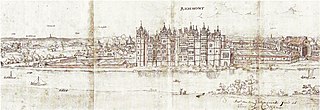
Richmond Palace was a Tudor royal residence on the River Thames in England which stood in the sixteenth and seventeenth centuries. Situated in what was then rural Surrey, it lay upstream and on the opposite bank from the Palace of Westminster, which was located nine miles (14 km) to the north-east. It was erected in about 1501 by Henry VII of England, formerly known as the Earl of Richmond, in honour of which the manor of Sheen had recently been renamed "Richmond". Richmond Palace therefore replaced Shene Palace, the latter palace being itself built on the site of an earlier manor house which had been appropriated by Edward I in 1299 and which was subsequently used by his next three direct descendants before it fell into disrepair.

Richmond Green is a recreation area near the centre of Richmond, a town of about 20,000 inhabitants situated in south-west London. Owned by the Crown Estate, it is leased to the London Borough of Richmond upon Thames. The Green, which has been described as "one of the most beautiful urban greens surviving anywhere in England", is roughly square in shape and its open grassland, framed with broadleaf trees, extends to roughly twelve acres. On the north-east side there is also a smaller open space called Little Green. Richmond Green and Little Green are overlooked by a mixture of period townhouses, historic buildings and municipal and commercial establishments including the Richmond Lending Library and Richmond Theatre.
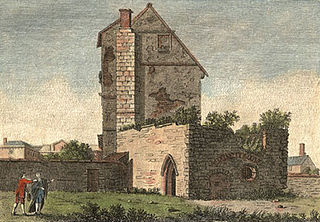
Beaumont Palace, built outside the north gate of Oxford, was intended by Henry I about 1130 to serve as a royal palace conveniently close to the royal hunting-lodge at Woodstock. Its former presence is recorded in Beaumont Street, Oxford. Set into a pillar on the north side of the street, near Walton Street, is a stone with the inscription: "Near to this site stood the King's Houses later known as Beaumont Palace. King Richard I was born here in 1157 and King John in 1166." The "King's House" was the range of the palace that contained the king's lodgings.

10 Palace Gate is an apartment block in Palace Gate, in the Kensington area of London, England, designed by Wells Coates.

Coade stone or Lithodipyra or Lithodipra is stoneware that was often described as an artificial stone in the late 18th and early 19th centuries. It was used for moulding neoclassical statues, architectural decorations and garden ornaments of the highest quality that remain virtually weatherproof today.
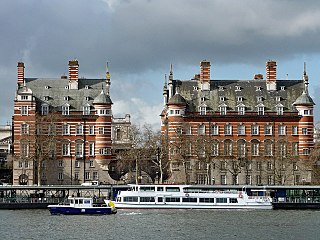
The Norman Shaw Buildings are a pair of buildings in Westminster, London, overlooking the River Thames. The buildings were designed by the architects Richard Norman Shaw and John Dixon Butler, between 1887 and 1906. They were originally the location of New Scotland Yard between 1890 and 1967, but from 1979, have been used as parliamentary offices and have been named Norman Shaw North and South Buildings, augmenting limited space in the Palace of Westminster.
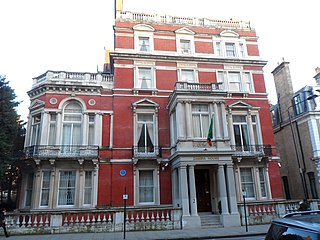
Palace Gate is a street south of Kensington Gardens in London, England. It was previously part of Gloucester Road, and was initially developed in the 1860s.

The Bull & Gate is a Grade II listed public house and former music venue at 389 Kentish Town Road, Kentish Town, London. The pub had a long history as music venue, with bands such as The Pogues, Coldplay, Blur, and Suede playing there towards the start of their careers.
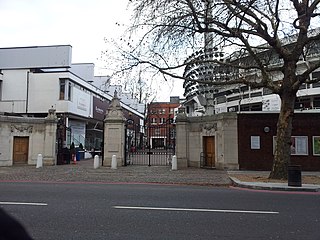
The Grace Gates, officially the W. G. Grace Memorial Gates, are two pairs of gates on St John's Wood Road at Lord's Cricket Ground in London, England. They were erected in 1923 and the gates with their flanking walls and piers became a Grade II listed building in 1996.

The Embassy of Peru in London is the diplomatic mission of Peru in the United Kingdom. The embassy is located in 15 Buckingham Gate, London, SW1E 6LB.

The King's Head is a Grade II listed public house at 84 Upper Tooting Road, Tooting, London SW17 7PB.

The London Apprentice is a Grade II* listed public house at 62 Church Street, Isleworth, London.
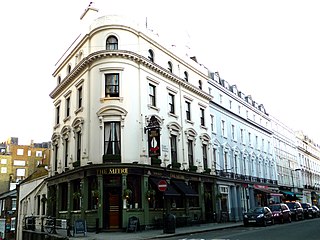
The Mitre is a Grade II listed public house at 24 Craven Terrace, Lancaster Gate, Bayswater, City of Westminster.

The Gate Cinema is a Grade II listed building in Notting Hill Gate, London W11.
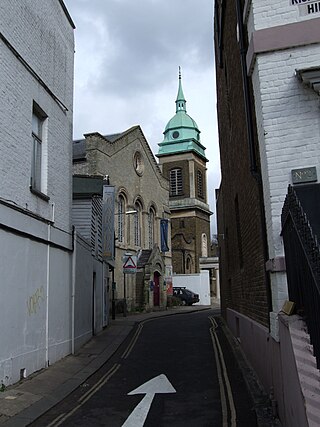
The Vineyard is a street in Richmond, in the London Borough of Richmond upon Thames. It includes three groups of almshouses, a Grade II listed church and Clarence House, a 17th-century Grade II listed house associated with Bernardo O’Higgins, who is commemorated on the wall of the property with a blue plaque, installed by English Heritage, for his role in the Chilean War of Independence.
Stud House is an early 18th-century house in the centre of Hampton Court Park near Hampton Court Palace. It is Grade II listed on the National Heritage List for England. It was traditionally the official residence of the Master of the Horse. The former stables at the house are separately listed, also at Grade II. The Stud House was built in the 18th century and was altered and expanded between 1817 and 1818.

The Pavilion is a house on Barge Walk in Hampton Court Park near Hampton Court Palace. It is Grade II* listed on the National Heritage List for England. It is the sole survivor of four pavilions for the Bowling Green at Hampton Court.

The Blythe Hill Tavern is a Grade II listed public house in Forest Hill, south London. It has been repeatedly voted amongst the top pubs in London including by Time Out in 2023.
51°30′05″N0°11′04″W / 51.50133°N 0.18437°W